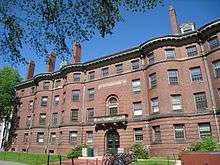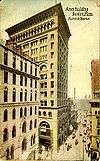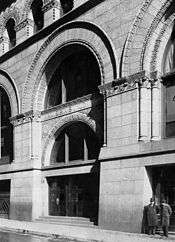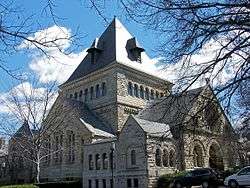Shepley, Rutan and Coolidge
Shepley, Rutan and Coolidge was a successful architecture firm based in Boston, Massachusetts, operating between 1886 and 1915, with extensive commissions in monumental civic and collegiate architecture in the spirit and style of Henry Hobson Richardson.
History
The firm grew out of Richardson's architectural practice. After Richardson's death at age 47 in 1886, a trio consisting of George Foster Shepley (1860–1903), Charles Hercules Rutan (1851–1914), and Charles Allerton Coolidge (1858–1936) gained control of the firm and completed all of its nearly two dozen pending projects, including the John J. Glessner House in Chicago. Many of Richardson's projects were completed and modified in stages over years, making exact attribution difficult for such buildings as the Ames Gate Lodge in North Easton, Massachusetts, and even Richardson's masterwork Trinity Church, Boston.
Two of the principals had been educated at the Massachusetts Institute of Technology: Shepley (class of 1882) and Coolidge (class of 1883). Shepley married Richardson's daughter; and Coolidge later married Shepley's sister.
In 1888, the firm was commissioned by Senator and Mrs. Leland Stanford to join landscape architect Frederick Law Olmsted in planning the campus for Stanford University. For major commissions in Chicago and the World's Columbian Exposition, Coolidge moved to Chicago and the firm opened its branch office there in 1893, in which many Prairie School architects received their early professional training, notably Hermann V. von Holst who was head draughtsman. A St. Louis branch office began the career of John Mauran; a Pittsburgh branch office developed into several firms, including Rutan & Russell formed by Frank Rutan, the younger brother of Charles. Other Pittsburgh firms developed by branch office employees include Longfellow, Alden & Harlow and Frank I. Cooper; Pasadena architect Myron Hunt spent three years with them in Boston as draftsman.
Stylistically, the firm continued to work mainly in the architectural vocabulary of Richardsonian Romanesque, although with less imagination—for instance, Richardson's asymmetry disappears. The firm continued as Shepley Rutan and Coolidge through 1915, then became Coolidge and Shattuck (Boston) and Coolidge and Hodgdon (Chicago) concurrently from 1915 through 1924, then Coolidge Shepley Bulfinch and Abbott from 1924 through 1952, Shepley Bulfinch Richardson and Abbott from 1952, and is still in operation as Shepley Bulfinch.
Work
- completion of the Franklin MacVeagh Residence, Chicago (1885–1887), razed 1922
- 23 stations for the Boston & Albany Railroad (1886 through 1894)
- * Newton Highlands (still standing)
- * Chatham, NY (still standing)
- * Allston (still standing)
- * Newton Lower Falls (located in Wellesley)
- * Ashland (still standing)
- * Reservoir
- * Dalton (still standing)
- * Springfield
- * Wellesley
- * Newton Centre (still standing)
- * Huntington
- * Warren (still standing)
- * Charlton
- * Brookline Hills
- * Hinsdale
- * Canaan, NY
- * Millbury
- * Riverside
- * Longwood
- * East Brookfield
- * Wellesley Farms (still standing)
- * Saxonville
- * East Chatham
- Bell Telephone Building, St. Louis, Missouri (1889)
- multiple buildings in the Harvard Avenue Historic District including the Allston Depot, Boston (1887)
- Main Quad and several other Mission Revival buildings for Stanford University, 1886 - 1906
- New London Public Library, New London, Connecticut (1889)
- Hartford Union Station, One Union Place, Hartford, Connecticut (1889), executed a design by George Keller[1]
- Shadyside Presbyterian Church, Pittsburgh, Pennsylvania (1890)
- Bell Telephone Building (St. Louis, Missouri) (1890), recently renovated into lofts
- Williams Memorial Institute, New London, Connecticut (1891)
- Newton Centre Station, Newton, Massachusetts (1891)[1]
- Old Toronto Board of Trade Building, Toronto, Ontario (1892), razed 1958
- Montreal Board of Trade Building, Montreal, Quebec (1892), design won by competition; destroyed by fire circa 1902
- Chicago Public Library (1892), design won by competition, now the Chicago Cultural Center
- Medfield State Hospital, Medfield, Massachusetts (1892)
- Flour and Grain Exchange Building, Boston (1892)
- Warren Railroad Station, Warren, Massachusetts (1892)[1]
- Lake Shore & Michigan Southern Station, Sandusky, Ohio (1892)[1]
- North Union Station (1893), razed 1927
- the 14-story Ames Building in Boston (1893)
- Art Institute of Chicago (1893), built as the "World's Congress Auxiliary Building" for the World's Columbian Exposition
- completion of Richardson's Trinity Church, Boston (1894–1897), refining the two west towers and adding the tripartite porch
- Conant Hall, Harvard University (1894)
- Coraopolis Train Station, Coraopolis, Pennsylvania (1895)[1]
- Guardian Bank Building, Cleveland, Ohio (1896)
- Medill / McCormick Residence, Cantigny Park, suburban Chicago (1896)
- Glenbard West High School main building in Glen Ellyn IL, completed in 1922 there after additions were made for an expanding student enrollment
- chapel at the Second Presbyterian Church, St. Louis, Missouri (1896)
- Congregational Library, Boston (1898)
- South Station (Boston) (1898)[1]
- Albany Union Station, Albany, New York (1899)[2][1]
- George Westinghouse Jones House, Niskayuna, New York, by Rutan & Russell (ca. 1900)
- Metropolitan Water Board, Chestnut Hill Pump Station, Boston (1900)

- master plan and more than fifteen buildings for the University of Chicago (1901–1915), including the Harper Library
- Manufactures and Liberal Arts Building and Agriculture Building for the Pan-American Exposition, Buffalo, New York (1901)
- Bartlett Gymnasium, University of Chicago, (1904)
- John Carter Brown Library, Brown University, Providence, Rhode Island (1904)
- Hildene, the Robert Todd Lincoln mansion, Manchester, Vermont (1905)
- a new campus for the Harvard Medical School (1906)
- Langdell Hall, Harvard Law School (1907)
- Corn Exchange Bank Building, also known as National Republican Bank, Chicago, Illinois (1908), razed circa 1985
- additions to Richardson's Hampden County Courthouse, Springfield, Massachusetts (1908–1912)
- Boston Safe Deposit Building, Boston (1908–1911)
- Union Station in Springfield, Massachusetts (1910)
- Harper Memorial Library, University of Chicago (1910-1912)
- Boston Young Men's Christian Association (1911)
- multiple buildings at the University of Nebraska (1914–1925)
- Temple Sholom of Chicago (assisting students at the School of Architecture at Armor Institute, now the Illinois Institute of Technology).
- Dallas Hall, Southern Methodist University, University Park, Texas (Dallas) (1915)
- Ida Noyes Hall, University of Chicago, Chicago, Illinois (1916)
- Rockland Railroad Station, Rockland, Maine (1917) (as Coolidge and Shattuck)[1]
Gallery

 Agriculture Building, at the Pan-American Exposition, designed by George F. Shepley
Agriculture Building, at the Pan-American Exposition, designed by George F. Shepley Conant Hall, Harvard
Conant Hall, Harvard Ames Building facade on contemporary postcard
Ames Building facade on contemporary postcard Ames Building arched entryway, Boston, circa 1894
Ames Building arched entryway, Boston, circa 1894 Harper Library seen from the Midway Plaisance, University of Chicago
Harper Library seen from the Midway Plaisance, University of Chicago- Dallas Hall, Southern Methodist University

 Schenley Park Café and Visitor Center, Pittsburgh, 1910
Schenley Park Café and Visitor Center, Pittsburgh, 1910 Tilden-Thurber jewelry company building in Providence, Rhode Island, 1895
Tilden-Thurber jewelry company building in Providence, Rhode Island, 1895
Sources
- online biography at University of Nebraska
- Lyndon, Donlyn. (1982) The City Observed: Boston, A Guide to the Architecture of the Hub. Vintage Books
- Pridmore, Jay, and Kiar, Peter, The University of Chicago: an architectural tour
- *Shepley, Rutan and Coolidge at the archINFORM database.
- Ochsner, Jeffrey Karl Ochsner, H.H. Richardson, Complete Architectural Works
- photos of 1890 Bell Telephone Building, St. Louis
References
| Wikimedia Commons has media related to Shepley, Rutan and Coolidge. |
- 1 2 3 4 5 6 7 8 Potter, Janet Greenstein (1996). Great American Railroad Stations. New York: John Wiley & Sons, Inc. pp. 66, 81, 85, 92, 97, 190, 396. ISBN 9780471143895.
- ↑ Liebs, Chester H. (July 1970). "National Register of Historic Places Inventory/Nomination: Albany Union Station". Retrieved 2009-04-18. and Accompanying two photos, exterior, from 1905 and undated
